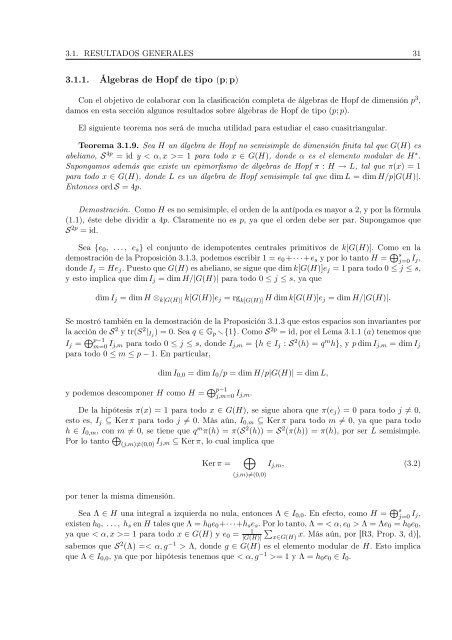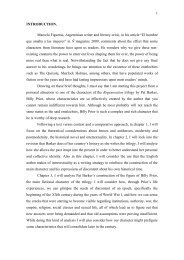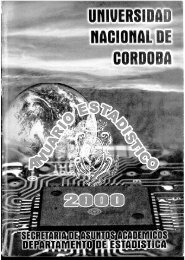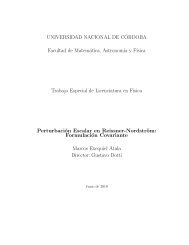Abrir - RDU - Universidad Nacional de Córdoba
Abrir - RDU - Universidad Nacional de Córdoba
Abrir - RDU - Universidad Nacional de Córdoba
You also want an ePaper? Increase the reach of your titles
YUMPU automatically turns print PDFs into web optimized ePapers that Google loves.
3.1. RESULTADOS GENERALES 31<br />
3.1.1. Álgebras <strong>de</strong> Hopf <strong>de</strong> tipo (p; p)<br />
Con el objetivo <strong>de</strong> colaborar con la clasificación completa <strong>de</strong> álgebras <strong>de</strong> Hopf <strong>de</strong> dimensión p 3 ,<br />
damos en esta sección algunos resultados sobre álgebras <strong>de</strong> Hopf <strong>de</strong> tipo (p; p).<br />
El siguiente teorema nos será <strong>de</strong> mucha utilidad para estudiar el caso cuasitriangular.<br />
Teorema 3.1.9. Sea H un álgebra <strong>de</strong> Hopf no semisimple <strong>de</strong> dimensión finita tal que G(H) es<br />
abeliano, S 4p = id y < α, x >= 1 para todo x ∈ G(H), don<strong>de</strong> α es el elemento modular <strong>de</strong> H ∗ .<br />
Supongamos a<strong>de</strong>más que existe un epimorfismo <strong>de</strong> álgebras <strong>de</strong> Hopf π : H → L, tal que π(x) = 1<br />
para todo x ∈ G(H), don<strong>de</strong> L es un álgebra <strong>de</strong> Hopf semisimple tal que dim L = dim H/p|G(H)|.<br />
Entonces ord S = 4p.<br />
Demostración. Como H es no semisimple, el or<strong>de</strong>n <strong>de</strong> la antípoda es mayor a 2, y por la fórmula<br />
(1.1), éste <strong>de</strong>be dividir a 4p. Claramente no es p, ya que el or<strong>de</strong>n <strong>de</strong>be ser par. Supongamos que<br />
S 2p = id.<br />
Sea {e 0 , . . . , e s } el conjunto <strong>de</strong> i<strong>de</strong>mpotentes centrales primitivos <strong>de</strong> k[G(H)]. Como en la<br />
<strong>de</strong>mostración <strong>de</strong> la Proposición 3.1.3, po<strong>de</strong>mos escribir 1 = e 0 +· · ·+e s y por lo tanto H = ⊕ s<br />
j=0 I j,<br />
don<strong>de</strong> I j = He j . Puesto que G(H) es abeliano, se sigue que dim k[G(H)]e j = 1 para todo 0 ≤ j ≤ s,<br />
y esto implica que dim I j = dim H/|G(H)| para todo 0 ≤ j ≤ s, ya que<br />
dim I j = dim H ⊗ k[G(H)] k[G(H)]e j = rg k[G(H)] H dim k[G(H)]e j = dim H/|G(H)|.<br />
Se mostró también en la <strong>de</strong>mostración <strong>de</strong> la Proposición 3.1.3 que estos espacios son invariantes por<br />
la acción <strong>de</strong> S 2 y tr(S 2 | Ij ) = 0. Sea q ∈ G p {1}. Como S 2p = id, por el Lema 3.1.1 (a) tenemos que<br />
I j = ⊕ p−1<br />
m=0 I j,m para todo 0 ≤ j ≤ s, don<strong>de</strong> I j,m = {h ∈ I j : S 2 (h) = q m h}, y p dim I j,m = dim I j<br />
para todo 0 ≤ m ≤ p − 1. En particular,<br />
dim I 0,0 = dim I 0 /p = dim H/p|G(H)| = dim L,<br />
y po<strong>de</strong>mos <strong>de</strong>scomponer H como H = ⊕ p−1<br />
j,m=0 I j,m.<br />
De la hipótesis π(x) = 1 para todo x ∈ G(H), se sigue ahora que π(e j ) = 0 para todo j ≠ 0,<br />
esto es, I j ⊆ Ker π para todo j ≠ 0. Más aún, I 0,m ⊆ Ker π para todo m ≠ 0, ya que para todo<br />
h ∈ I 0,m , con m ≠ 0, se tiene que q m π(h) = π(S 2 (h)) = S 2 (π(h)) = π(h), por ser L semisimple.<br />
Por lo tanto ⊕ (j,m)≠(0,0) I j,m ⊆ Ker π, lo cual implica que<br />
por tener la misma dimensión.<br />
Ker π =<br />
⊕<br />
(j,m)≠(0,0)<br />
I j,m , (3.2)<br />
Sea Λ ∈ H una integral a izquierda no nula, entonces Λ ∈ I 0,0 . En efecto, como H = ⊕ s<br />
j=0 I j,<br />
existen h 0 , . . . , h s en H tales que Λ = h 0 e 0 +· · ·+h s e s . Por lo tanto, Λ = < α, e 0 > Λ = Λe 0 = h 0 e 0 ,<br />
ya que < α, x >= 1 para todo x ∈ G(H) y e 0 = 1<br />
|G(H)|<br />
∑<br />
x∈G(H)<br />
x. Más aún, por [R3, Prop. 3, d)],<br />
sabemos que S 2 (Λ) =< α, g −1 > Λ, don<strong>de</strong> g ∈ G(H) es el elemento modular <strong>de</strong> H. Esto implica<br />
que Λ ∈ I 0,0 , ya que por hipótesis tenemos que < α, g −1 >= 1 y Λ = h 0 e 0 ∈ I 0 .
















